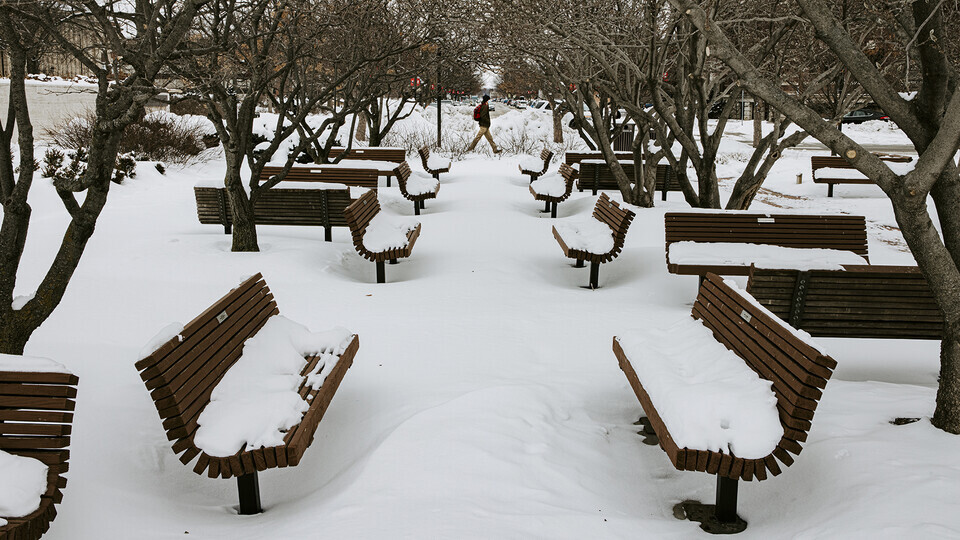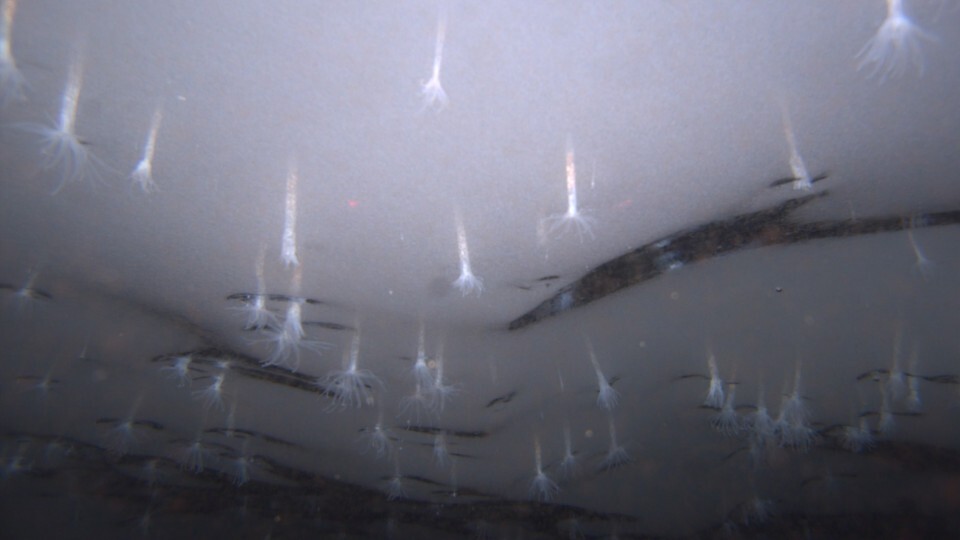
The lip-chapping, teeth-chattering Arctic blast of sub-zero cold that has descended on Nebraska proved bitter enough to cancel in-person classes on Feb. 15 and 16.
As documented by Ken Dewey, professor emeritus of climatology, Lincoln’s temperatures have been approaching and even plunging past record lows in recent days.
Yesterday's high +6°F was a record cold daily high (old record +9°F). Today started out at 0°F & is our high for the day. At 8am we were -5°F, wind chill -26°F. Much colder to our N. Worst of the cold wave today thru Tues. am. Then a gradual warming out of our glacial conditions pic.twitter.com/ydGJvvSMOO
— Ken Dewey (@kdewey1unl) February 14, 2021
Tracy Frank, professor of Earth and atmospheric sciences, found a more visceral way to illustrate just how paralyzingly frigid the Nebraska air has turned.
How cold is it today in #Nebraska? pic.twitter.com/1aKlC6QIlj
— Tracy Frank (Dr. as in, PhD) (@DrTracyfrank) February 14, 2021
But then, cold snaps are old hat for stocking cap-equipped Nebraskans. Read on for a few examples of how Huskers have learned to embrace, or at least brace for, the eye-blearing chills that strike Nebraska and other wintry climes.
When cell freezes over
Some people handle the cold better than others. Plants are no different: The flowering plant Arabidopsis thaliana, for instance, manages better than does the crop synonymous with the Cornhusker State.
Husker biochemist Rebecca Roston and her colleagues are knee-deep in studying how the cells of some cold-tolerant plants respond to freezing temperatures. Deciphering the complex chain of biochemical commands that protect cells against permanent damage in some plant species should eventually allow researchers to engineer similar resilience in corn and other crops, lengthening their growing seasons and ultimately upping yields.
Electric avenue
Homeowners looking to clear ice from driveways — and cities tasked with clearing it from roadways — often turn to salt or de-icing chemicals. Though usually effective, they also degrade concrete over time, contributing to cracks and suspension-jarring potholes.
By adding steel shavings and carbon particles to an age-old concrete recipe, Husker engineers Chris Tuan and Lim Nguyen developed a form that conducts enough electricity to melt ice and snow. In 2002, Lincoln’s Roca Spur Bridge became the first to incorporate the conductive concrete, serving as a case study that has aced every test Nebraska’s winters have thrown at it. More recently, Tuan and his son founded a startup and helped incorporate the de-icing concrete into boarding platforms along Kansas City bus routes.
Nice ice, maybe
Ice makes its home on more than just concrete, of course, as anyone who’s spent five miserable minutes scraping a windshield — or 10 waiting for a defroster to kick in — can attest.
Nebraska chemist Xiao Cheng Zeng and fellow researchers discovered that ice grows upward from water-repellent surfaces, making it far easier to remove than when it grows flat, as it does on more absorbent surfaces. In fact, the team showed that even a gust of wind can sometimes remove ice from a water-repelling surface.
Drills and shelves
About 9,000 miles south-southwest of Lincoln, melting or brushing off ice is not an option. To get at what’s below the rapidly dissipating but still formidable slabs of ice in Antarctica, Husker researchers and international colleagues have for decades used massive drills to access underlying rock cores and other scientific curiosities. One of those curiosities: a previously unknown species of sea anemone that was found burrowing into the underside of the Ross Ice Shelf.

The same Antarctic Geological Drilling Program that discovered the sea anemone also extracted a 3,375-foot-long-sample of rock from beneath McMurdo Sound. That rock, a geologic library of Earth’s climate history that dates back tens of millions of years, suggests that the sea level could rise as much as 100 feet if the human-driven surge in atmospheric carbon dioxide continues on its current trajectory.
The mightiest mouse
The interior of an active volcano can generate some serious heat, but the 22,000-foot summit of a dormant one — specifically Llullaillaco (zhoo-zhuh-ZHEYE’-koh), which straddles the Chile-Argentina border — is a cold place, indeed.
On that peak, the temperature can plummet to minus 75 degrees Fahrenheit. Given the cold and scarcity of oxygen, which is just 45% of the amount available at sea level, it was hardly a surprise that no one had ever observed a mammal living at that altitude. No one, that is, until Nebraska biologist Jay Storz and elite mountaineer Mario Pérez Mamani found a yellow-rumped leaf-eared mouse scurrying atop Llullaillaco in February 2020.
Said Storz: “It’s hard to overstate the hostility of the environment that these mice call home.”







